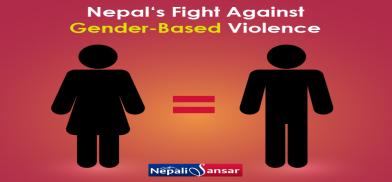Climate change and gender-based violence in Nepal: Vulnerabilities of women and children
After the 2015 earthquakes in Nepal, human trafficking spiked. There were even early and forced marriages and widows were at risk of receiving unwanted sexual attention. Since there is hardly any gender-neutral discourse to the mitigation of gender-based violence after climate change, attempts are increasingly being made to change the gender-blind discourse on climate change and disaster management.

South Asia has experienced a lot of catastrophic changes and one of the notable changes is climate disasters. Amongst South Asian countries, demographically and otherwise Nepal has faced severe damages due to displacements which are often involuntary. What is clearly witnessed is a prominent connection between climate change, vulnerabilities of migrant women and human security.
In the modern era, human security covers the spectrum of human rights and climate change is a human rights imperative that needs to be addressed. While migration is a sustainable livelihood strategy, often people are forced to migrate due to environmental degradation like floods, droughts, storms and other natural disasters which obviously they had not anticipated before. Therefore, climate change intersects migration at various points nationally and internationally. Due to such sudden changes, women are most disproportionately affected and the fallout on them is the most critical, severe and transformative. They face additional risks because they are women and the most vulnerable section of the population and bear the brunt of gender inequities.
Often social norms and gendered cultural entrenchments affect their coping strategies and restrain their mobility in crises. During such climate-induced changes, women face various types of discrimination and abuses----for instance intimidation, intimate partner violence (often faced by them in normal times too!), sexual harassment and rape apart from organized crime like trafficking. Thus, they are the most high-risk population. It’s not to say that men and boys are not at risk. However, the vulnerabilities of women and girls are greater. They not only have limited resources like land and assets; they have little or no access to the resources of their families.
In Nepal, an estimated 12,000 to 20, 000 women and children, including boys, are abducted and deceived into forced labour and brothel-based sex work every year. (Source: UNEP: Women Most At Risk From Climate Disasters, Says UN Report, December 6, 2011. URL: https://www.preventionweb.net/news/unep-women-most-risk-climate-disasters-says-un-report)Many are affected irreversibly changing their lives with HIV/AIDS infections. Estimates emerging from data provided by anti-trafficking organizations like Maiti Nepal suggest that trafficking may have increased from an estimated 3000-5000 in the 1990s to 12,000-20,000 per year. (Source: UNEP: Women Most At Risk From Climate Disasters, Says UN Report, December 6, 2011. URL: https://www.preventionweb.net/news/unep-women-most-risk-climate-disasters-says-un-report)
Indeed, Interpol has also warned that disasters exacerbate inequalities and vulnerabilities on women, especially trafficking. Responsibilities, perceptions and distorted power relations tend to put women at a disadvantage.
Spike in human trafficking
After the 2015 earthquakes in Nepal, human trafficking spiked. There were even early and forced marriages and widows were at risk of receiving unwanted sexual attention. Since there is hardly any gender-neutral discourse to the mitigation of gender-based violence after climate change, attempts are increasingly being made to change the gender-blind discourse on climate change and disaster management. For example, in Nepal, the Asia Foundation and a consortium of social entrepreneurs developed the Shuvayatra app, a tool for Nepali migrant labourers to plan for safe work abroad in environments that are often dangerous, illegal and abusive. Many have fallen to adversity that traps them abroad, especially in the Gulf regions and the Middle East.
However, what is worse is that at home too migrant returnees are left vulnerable in times of distress like increasing floods and landslides. For instance, when massive landslides and floods hit western Nepal in August 2014, surging water took away protection against unwanted pregnancies and HIV infections for many migrants as well as indigenous women. During disasters, access to reproductive health services naturally becomes difficult.
Women do not get a fair chance at surviving climate changes and climate-induced disasters. In the SDGs, gender is integrated into the goals, and gender equality serves as a key theme throughout the agenda. As the International Bar Association noted in a 2015 report on the relationship between gender and climate change, “Gender equity is also an essential element of climate change justice…. As climate change accelerates migration and displacement, women, in particular, are subject to abuse and deprivation.” They not only face adverse situations in normal times but also encounter acute and differential impacts of climate change in times of distress. This reduces the potentiality of women to fight back.
Vulnerability of gender
In the DFID review titled Women, Girls and Disasters, Sarah Bradshaw and Maureen Fordham argue that the ‘real’ disaster for women and girls is not the primary impact but the secondary impact felt in the form of intangible changes to their well-being. Violence and abuse threaten the survival and well-being of women which is a greater ‘disaster risk.’ When women are displaced and forced to shift from their homes during disasters they face risks of security, lack of privacy, and sanitation problems which increase their vulnerabilities manifold.
The women stand at the intersection of vulnerabilities. It is important to identify and define what we mean by the vulnerabilities of women in climate-induced disasters and how we can minimise them. Vulnerability is often a function of an individual’s gender. It means vulnerability is not only biological or economic but socially constructed. Disaster sociologist, Elaine Enarson argues gendered vulnerability is derived from intersecting identities and social relationships. This means power relationships shape experiences of oppression. What is worse is that even in post-reconstruction plans women do not get agency. They are poorly represented. Therefore, women have hardly any say in reshaping agendas for themselves. This aggravates the problems for them instead of mitigating these issues.
Nepal is working towards reversing the imbalanced burden on women by talking about climate finance in the recently concluded COP27 summit at Sharm-al-Shaikh, Egypt where issues like gender-responsive climate change policy have been raised.
(The writer is Assistant Professor, Department of Political Science, Jangipur College, Kalyani University, West Bengal. Views are personal. She can be reached at koyelbasu1979@gmail.com.)














Post a Comment